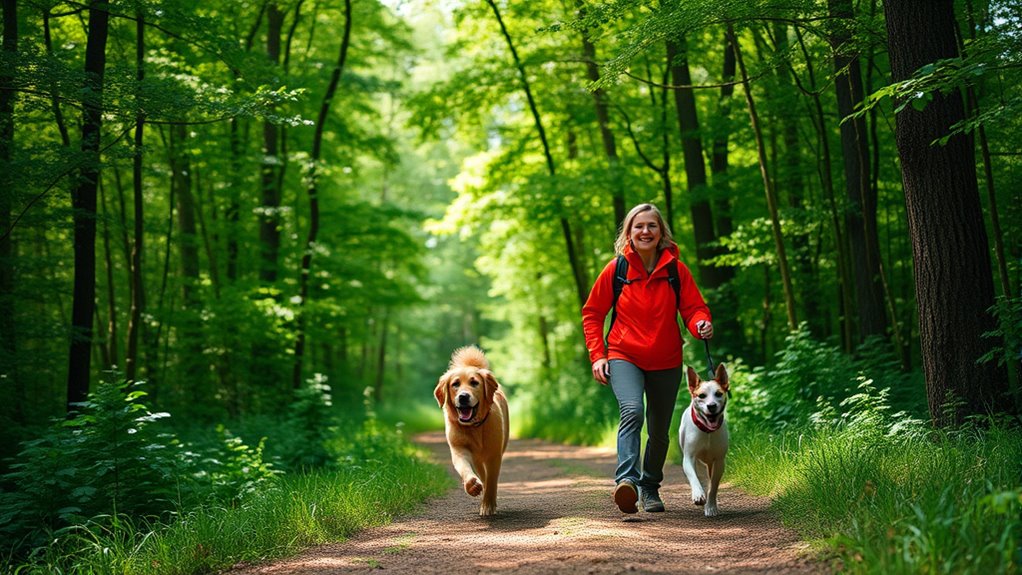When hiking with your dog, always follow trail etiquette to guarantee safety and respect for others. Keep your dog on a leash unless in designated off-leash areas, and practice recall skills regularly. Carry waste bags and clean up after your dog to protect the environment. Respect local rules and seasonal restrictions, and be mindful of other hikers and wildlife. Continuing with these tips helps create a positive experience for everyone on the trail.
Key Takeaways
- Keep your dog on a leash unless in designated off-leash areas to respect trail rules and wildlife.
- Practice and reinforce recall commands to ensure control and prevent unwanted interactions.
- Carry waste bags and clean up after your dog to maintain trail cleanliness and environmental health.
- Respect seasonal restrictions and specific trail regulations for off-leash zones and protected areas.
- Maintain proper control and avoid disturbing other hikers or wildlife for a safe, enjoyable hiking experience.

Ever wondered how to make your outdoor adventures with your canine companion safer and more enjoyable? It all starts with understanding some fundamental trail etiquette, especially when it comes to dog training and leash laws. Before you hit the trail, spend time ensuring your dog is well-trained. Basic commands like sit, stay, and come are essential for keeping your dog under control and preventing mishaps in unfamiliar environments. Proper training helps your dog understand boundaries and respond promptly to your commands, making the hike smoother for both of you. Equally important is being aware of leash laws in the area. Many parks and trails require dogs to be leashed at all times to protect wildlife, other hikers, and your pet. Following these laws not only keeps you compliant but also shows respect for the shared space, avoiding potential fines or conflicts.
When you’re on the trail, always keep your dog on a leash unless the area explicitly permits off-leash activity. This prevents your dog from running off after wildlife, approaching other hikers unexpectedly, or venturing into unsafe terrain. Use a sturdy leash and harness suited to your dog’s size and strength, ensuring you can maintain control even if your dog gets excited or startled. If your dog responds well to voice commands, practice calling them back frequently during your hike, reinforcing their recall skills. This will help prevent your dog from chasing after animals or other distractions, keeping everyone safe.
Additionally, it’s your responsibility to be aware of local regulations regarding dogs. Some trails might have designated off-leash zones or specific restrictions during certain seasons. Respect these rules to avoid conflicts and ensure everyone can enjoy the outdoors. Keep in mind that a well-trained dog is less likely to cause disturbances, so investing time in training pays off in the long run. Also, carry waste bags and clean up after your dog. Not only is this courteous, but it also helps maintain the trail’s natural beauty and adheres to park rules.
Frequently Asked Questions
Can Dogs Hike Safely in Extreme Weather Conditions?
You might wonder if dogs can hike safely in extreme weather. In such conditions, weather preparedness is essential. Always carry enough water for your dog to stay hydrated, especially in hot weather, and provide shade when possible. In cold weather, protect their paws and keep walks shorter. Watch for signs of distress, and never push your dog beyond their limits. Your vigilance ensures a safe, enjoyable hike for both of you.
How Do I Prevent My Dog From Disturbing Wildlife?
To prevent your dog from disturbing wildlife, keep them on a leash and under control at all times. Avoid letting them chase or bark at animals, which can disrupt trail harmony. Stay on designated paths and maintain a respectful distance from wildlife. By doing so, you safeguard local ecosystems and ensure everyone enjoys the trail peacefully. Your mindful actions help preserve wildlife and promote a harmonious outdoor experience.
What Should I Do if My Dog Gets Lost?
Like Odysseus facing the unknown, you’ll need calm during a lost dog situation. Act quickly with trail search strategies, calling your dog’s name and using familiar scents. Contact nearby parks or ranger stations for lost dog recovery help. Keep a recent photo handy, and consider using GPS tags or microchips to reunite faster. Staying composed and proactive maximizes your chances of finding your furry companion swiftly.
Are There Specific Leash Laws for Dogs on Trails?
You should always check local leash regulations before hitting the trail, as many parks require dogs to be on a leash at all times. Some areas might have specific leash laws or trail permits that you need to follow, so review these rules beforehand. Keeping your dog leashed not only keeps them safe but also respects other hikers and wildlife, ensuring a positive experience for everyone on the trail.
How Can I Train My Dog to Obey Trail Commands?
Training your dog to obey trail commands is like teaching a song—repetition makes perfect. Use effective dog training techniques and command reinforcement strategies to build a strong response. Start with basic commands like “sit” and “heel,” practicing regularly. Reward good behavior with treats or praise, and stay consistent. Before hitting the trail, confirm your dog understands and responds reliably, making your hike safer and more enjoyable for everyone.
Conclusion
Remember, hiking with your dog is a shared adventure that requires respect and care. Keep your furry friend leashed, clean up after them, and stay on designated trails—think of it as your modern-day Hippocratic Oath to safeguard nature’s delicate balance. By practicing good trail etiquette, you ensure countless more adventures together. So, pack your patience and a sense of wonder—after all, even in this digital age, some things, like true companionship, remain timeless.










